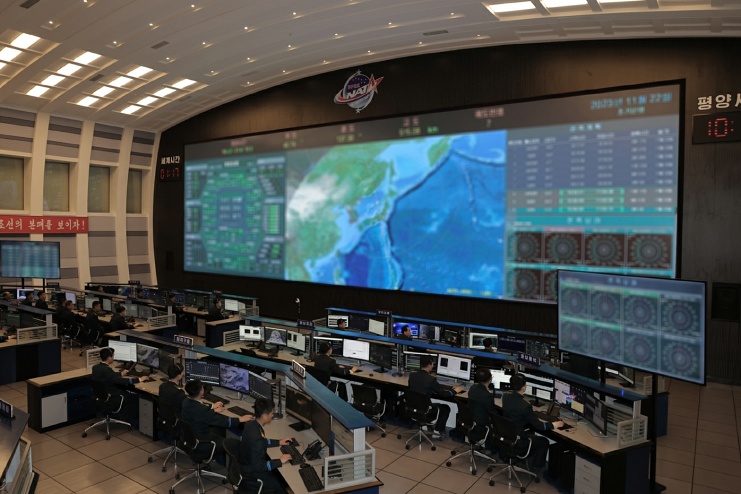 A photo of the Pyongyang General Control Tower published in state media on November 23, 2023. (Rodong Sinmun-News1)
A photo of the Pyongyang General Control Tower published in state media on November 23, 2023. (Rodong Sinmun-News1)Kim Jong Un has ordered North Korea’s military to build an integrated command system linking reconnaissance satellite data with the Reconnaissance General Bureau (RGB), aiming to analyze enemy movements and issue orders in real time.
A source in the military told Daily NK recently that the Central Military Commission “issued an order signed by Kim Jong Un to connect intelligence gathered by military reconnaissance satellites with the General Satellite Control Center’s command and transmission system in real time.”
He said that “technical teams from five specialized agencies, including the General Satellite Control Center, the RGB, and the Academy of National Defense Science’s Electronic Weapons Institute, were tasked with forming a task force.”
Another military source said that Kim “called for reconnaissance satellites, the General Satellite Control Center, and the RGB to be connected as one command and control system so that enemy movements are analyzed and translated into orders as soon as they are detected.”
Building an integrated intelligence system
In the order, the relevant agencies were instructed to focus on several key objectives: accelerating the preprocessing of satellite imagery, combining and analyzing signals and communications intelligence, automatically relaying commands to the RGB’s operational units, and duplicating the fiber-optic cables of underground facilities while strengthening defenses against electronic warfare.
The order also called for the construction of an “integrated information platform” that simultaneously processes satellite and electronic intelligence.
This suggests the authorities are attempting to implement a modern command concept that integrates satellite intelligence collection and analysis with the drafting and execution of orders.
The move indicates North Korea has been considering how to operationally integrate data from its Malligyong-1 reconnaissance satellite since announcing its launch in November 2023. At the time, North Korea claimed to have successfully put the satellite into orbit, but its capabilities were never independently verified.
North Korea’s National Aerospace Development Administration (NADA) built its General Satellite Control Center in Pyongyang in 2015. Signs have emerged on several occasions that the authorities wish to expand the facility. The task force appears to be an effort to develop the country’s basic space infrastructure in line with operational needs.
Protecting critical infrastructure
The authorities are simultaneously taking measures to defend the General Satellite Control Center from attack by moving facilities underground, enhancing defenses against electronic warfare, and diversifying communication frequencies. This is part of a strategy to harden the facility and prevent attempts to paralyze the command system in wartime.
However, some North Koreans have quietly pointed out that the country lacks the technological capacity to implement a command system that collects and analyzes satellite information and drafts orders in real time. “To process satellite data, you need not only a high-speed communication network but also the support of a large-scale computing network. Currently, North Korea’s system operates on delayed data, not real-time delivery,” one source said.
Nevertheless, some view the order to establish a real-time satellite command system as a significant endeavor. Another military source said the latest task “might face technical limitations, but it would become a threat the other side can’t ignore as an attempt to complete a command structure that can’t be severed in wartime.”
